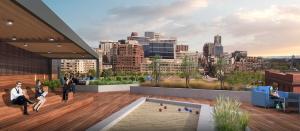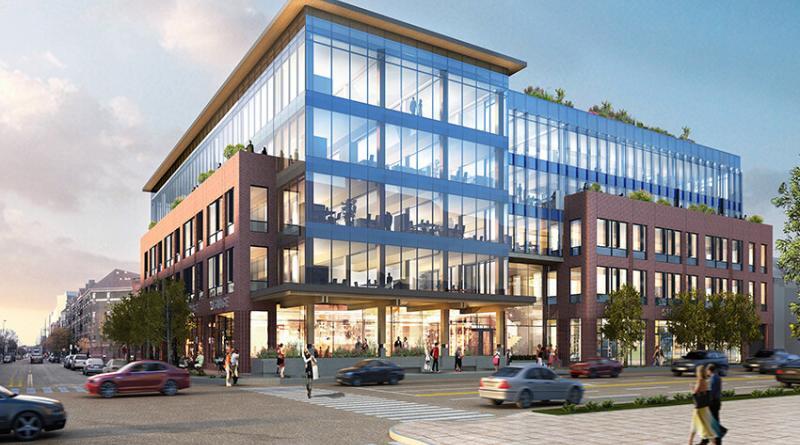First Impression – Platte 15 Takes Shape with CLT
As an innovative structural solution spreads, Platte Fifteen takes shape with CLT
By Sean O’Keefe
Commercial construction, like a lot of things, comes down to making choices. After selecting a site upon which to build, one of the most fundamental decisions on any new construction project is the building’s structural system. Whether steel, concrete, masonry, wood, or whatever, the structural system and the materials used to erect it impact virtually every other design decision made. Each system’s selection also carries a series of schedule, cost, and risk implications for the contractors responsible for erecting them. A bold new choice in structural solutions has entered the U.S. commercial market. Being built seemingly one project at a time, owners, architects, and contractors are getting to know CLT.
“Building is a set of calculated compromises,” says Conrad Suszynski, Co-CEO of Crescent Real Estate, LLC, (Crescent) developers of Platte Fifteen, currently under construction on the corner of 15th and Platte in Denver. At five stories tall and 156,915 square-feet, Platte Fifteen’s mix of uses will include office, retail, and parking, all supported by a pre-fabricated, wooden structural system that will define the building’s architectural character. “With CLT, wood now has fewer compromises than before,” continues Suszynski, “which makes it easier to use.”
CLT, or Cross Laminated Timber, is made from young, sustainably-harvested trees. Trunks are cut into layers and the wood is laminated together at alternating angles to form a reliable, high-density composite. The finished members are five times lighter than concrete yet have the strength of steel and retain the natural look of an old-growth timber beam. Though CLT has been used in custom homes and commercially in Europe for some time, only recently has it become a viable structural option for commercial buildings across
the U.S.
“We like brick and timber. Natural materials, open spaces, and daylight engage today’s employees and allow them to be more productive in an office environment,” says Suszynski.
“Wood is the correct choice for this context. It has great sound attenuation, it’s aesthetically pleasing, and as an exposed structure, it will help to reduce future tenant improvement costs.”
The context at 15th and Platte is a changing tapestry of old, new, and new interpretations of old connecting LoDo and LoHi. It is an intersection of then, now, and tomorrow bound by the South Platte River on the east and I-25 on the west. The remaining original, two- and three-story red brick buildings along Platte Street still proudly proclaim Denver’s frontier past.
Crescent’s design team for the project, led by OZ Architecture (OZ), deftly mixed materiality with surrounding rhythms and vernacular to establish Platte Fifteen as a wholly distinct presence. A stout, three-story brick base will embrace the historic streetscape, while a modern glass intervention is trimmed by a collection of rooftop decks. Window patterning studies of neighboring historic buildings and hand-selecting a rich, red brick will articulate a sense of authenticity to occupants while the sleek glass box symbolizes success to tenants. A covered paseo will highlight first-floor retail, wrapping the corner in activity, energy, and appeal just a block from Denver’s original seed on the banks of Confluence Park.
 “This is the first CLT project to be permitted by the City and County of Denver,” says Amanda Johnson, an Associate Principal at OZ, a firm from Colorado roots of 54 years. Johnson enjoyed the opportunity to explore CLT’s ability to be used as a single-source structural solution composed of prefabricated columns, beams, walls, and floors throughout the building. She expects Platte Fifteen to be a proud exemplar for CLT construction and coordination in the future as the product’s use continues to spread. She feels particularly confident about the effect CLT is going to have on the user experience. “They may not know it yet, but the people who occupy this building are going to love it.”
“This is the first CLT project to be permitted by the City and County of Denver,” says Amanda Johnson, an Associate Principal at OZ, a firm from Colorado roots of 54 years. Johnson enjoyed the opportunity to explore CLT’s ability to be used as a single-source structural solution composed of prefabricated columns, beams, walls, and floors throughout the building. She expects Platte Fifteen to be a proud exemplar for CLT construction and coordination in the future as the product’s use continues to spread. She feels particularly confident about the effect CLT is going to have on the user experience. “They may not know it yet, but the people who occupy this building are going to love it.”
OZ and Crescent’s first CLT collaboration, and the first such project completed in Colorado, was the Loading Dock, an adaptive reuse of a Boulder warehouse property as modern office space. “We admire Crescent’s willingness to push boundaries and explore how this unique product can change the conversation in commercial buildings,” says Johnson of the succession of scale over the two commissions.
Pushing boundaries in design and delivering them in construction are distinct challenges. On Platte Fifteen, the latter fell to Adolfson & Peterson Construction (AP). Jeff Stroup, the firm’s project manager, says he personally has found the pre-coordination and constructability challenges of working with CLT fresh and invigorating after more than twenty years in the game. Stroup recalls the moment in the contractor selection interview when the owner and architects asked if the prospect of working with CLT scared them, suggesting it was a good question. From building an exposed wooden structure in Colorado’s unpredictable weather to facing unknown costs and logistics, there is a fair amount of risk to consider. Accounting for the intense coordination required to conceal the building’s systems and the need to protect structural members from accidental damage during construction, the complications of building with CLT for the first time will be new challenges for many.
“There was a lot of intense collaboration between the owner, the architect, and builder from a cost and constructability perspective in preconstruction,” says Stroup. All involved admit the biggest initial hurdle was establishing a full-building CLT solution that could be built within budget without compromising the wow factor required of today’s premium office properties. Ultimately through design and constructability scrutiny, the team was able to put together a building plan that brought the CLT solution in at a slight premium to concrete or steel.

“Good communication and collaboration have gotten us this far,” says Stroup of the construction phase, as crews and equipment move across the excavated site behind him. “Teamwork and tenacity will take it from here.”
Platte Fifteen broke ground in early 2018 and is expected to be complete by October 2019. Since the CLT is exposed structural systems, walls, and ceilings all contribute as the primary driver of Platte Fifteen’s interior aesthetics. Stroup points out that simple selection of a CLT manufacturer can have huge implications as variations in wood or manufacturing techniques determine what is aesthetically possible. Prefabrication is imperative and CLT manufacturers are continually working to improve their processes to produce stronger and more beautiful finished products. Platte Fifteen’s CLT members are made from Black Spruce, harvested from Quebec province, Canada, and prefabricated into the required components by Nordic. A surface-applied coating will give each member a faded white hue similar to the bark of an Aspen in fall, lending interiors a soft sense of quiet calm that feels quite Colorado.
Concealing building systems also required intense advance coordination because there is almost no room for rework in the field. CLT members can’t be penetrated or moved once they are placed and offer just a 1/16th of an inch of tolerance. Building Information modeling and predictive clash detection are vital resources for clean, international construction. AP also brought in specialized contractors, Murphy Mechanical and Encore Electrical in a design-assist capacity to support the preconstruction planning, which increased confidence in construction commitments. Concern for columns and beams, once they are placed, is also important with CLT because the structural system is largely exposed and easily marred. The manpower, heavy equipment, and common installation processes required in the early phases of commercial building construction aren’t well adapted to working around finished surfaces and rework isn’t always an option.
 Suszynski shares that it was AP’s strong interest in previsualizing everything in advance, expressed from the onset of the project, that gave him confidence in the project’s achievability. Asked about the bigger picture and long-term implications of Platte Fifteen as an addition to Denver’s urban fabric, Suszynski’s response is both surprising
Suszynski shares that it was AP’s strong interest in previsualizing everything in advance, expressed from the onset of the project, that gave him confidence in the project’s achievability. Asked about the bigger picture and long-term implications of Platte Fifteen as an addition to Denver’s urban fabric, Suszynski’s response is both surprising
and insightful.
“I don’t believe commercial development cost trajectories can continue upward unabated. It’s not sustainable,” says Suszynski. Along with architects and builders, Suszynski insists savvy developers must also be considering ways to spend efficiently and produce more for less. “We see a many advantages to using CLT when the context, the creativity, and the commitment required can all be harnessed collectively.”

